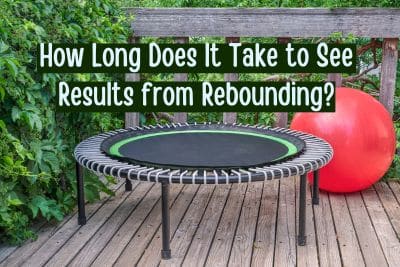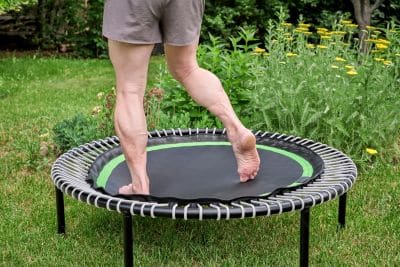Rebounding is an effective exercise where you bounce on a mini trampoline. It’s been getting a lot of attention in the fitness world because it’s easy to do and has tons of health benefits. But you might be wondering, ‘How long does it take to see results from rebounding?’. It may take 8 to 12 weeks to see results from rebounding. But this actually varies from person to person, depending on the rebounding period, intensity, and a few more things.
I’ve looked into all the details of rebounding to give you a complete answer to this burning question. Also, I’ll cover the topic of how many times you should rebound daily.
How Long Does It Take to See Results from Rebounding?
Before we talk about how long it takes, let’s go over the benefits of rebounding. This exercise works out your whole body, from your toes to your head, and targets multiple muscle groups with each bounce. Plus, rebounding is great for your heart, helps with lymphatic drainage, improves balance, and has so many other health benefits.

Factors That Affect Rebounding Results
The time it takes to see results from rebounding can vary depending on:
a) Intensity and Duration
Just like any workout, the more intense and longer your rebounding sessions, the faster you’ll see results. A gentle 15-minute bounce will have different results compared to a high-intensity 30-minute session.
b) Consistency
Regularity is key. Bouncing once a week won’t give you results as quickly as rebounding three to five times a week.
See Also: Rebounding outfits ideas
c) Diet and Lifestyle
Even if you have a rigorous rebounding routine, unhealthy eating and a sedentary lifestyle outside of your sessions can undermine your progress.
See Also: Things to know on trampoline in period
Rebounding Results Timeline
Based on various factors, here’s a general timeline of what you can expect:
i. First 1-2 Weeks
You’ll start feeling a difference in your energy levels. Improved lymphatic drainage might detoxify your system, leading to clearer skin and better digestion.
ii. 3-4 Weeks
You’ll notice improved cardiovascular fitness. Activities like climbing stairs or doing other aerobic exercises might become easier. Your balance and muscle tone may also start to improve.
iii. 5-8 Weeks
If you’ve been consistent, you might start seeing weight loss (if that’s your goal) and a more toned appearance. Your core strength will have improved, which can help with posture and reduce back pain.
iii. 2-3 Months
Besides the physical changes, many rebounders report improved mental well-being, sharper focus, better mood, and reduced anxiety.
Pro Tips:
Remember that everyone’s body responds differently. Some people may see rapid changes, while others might take longer. Listen to your body, adjust your routines as needed, and most importantly, enjoy the process!
See Also: Trampoline for pregnancy guide
How Many Times a Day Should You Rebound?
Rebounding, or bouncing on a mini-trampoline, has gone from being a childhood game to a highly recommended fitness routine. It’s not just fun; it offers significant health benefits. As more people get into rebounding, a common question arises: How many times a day should I rebound?

1. The Beginner’s Guide
If you’re new to rebounding, it’s important to start slowing and not overdo it.
Duration
Start with a comfy 5–10-minute session once a day. It’s important to get used to the movement and let your muscles adjust.
Frequency
Once a day for the first week is enough. As you build stamina, you can gradually increase the duration or add a second short session if you want.
See Also: Rebounding barefoot vs shoes debate
2. The Enthusiast’s Routine
Once rebounding becomes a regular part of your fitness routine:
Duration
Most enthusiasts find that 15-30 minutes per session hits the spot. It gives you a good workout without pushing your body too hard.
Frequency
Doing it twice a day can be beneficial – once in the morning to get your metabolism going and once in the evening to shake off the day’s stress. But always listen to your body. If once a day feels right, stick with that.
See Also: Rebounding before bed tips
3. Expert’s Rebounding Schedule
For those who’ve mastered rebounding and want to push themselves:
Duration
Advanced routines can go from 30 minutes to an hour. But it’s important to mix up the intensity and movements to avoid getting bored or injured.
Frequency
Even for advanced rebounders, twice a day is usually the most. Make sure to give your body enough time to recover between sessions.
See Also: Rebounding tricks
Factors to Consider on How Often You Need to Rebound
Your Goals
Are you rebounding to lose weight, improve lymphatic drainage, or just for fun? Your goals can affect how long and how often you bounce.
Other Activities
If rebounding is part of a bigger fitness routine, you might not need to do it as often.
Body’s Feedback
Always listen to your body. If your muscles are sore, you’re tired, or feeling any discomfort, it means you need to take it easy and reevaluate.
See Also: Rebounding testimonials
Takeaways
Rebounding is a dynamic exercise that you can customize to your needs. While it’s tempting to bounce multiple times a day because it’s fun, it’s important to find a balance. Remember, it’s not just about how much you do, but the quality of your workout.
While it’s exciting to see physical results, the intangible benefits – like improved mood and increased energy – make rebounding truly rewarding. So, get bouncing and let the magic of rebounding transform you from the inside out!

Rebecca is a fitness nerd and mother. She was inspired to get into the world of trampolining and rebounding by her husband Robert, who is a well-respected trainer and expert in the field. Now she instructs children, mothers, and teens the basic trampolining and rebounding tricks.
Rebecca is also a passionate blogger, sharing her knowledge and experiences with others in the hope of encouraging them to give trampolining and rebounding a try.
